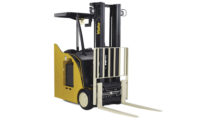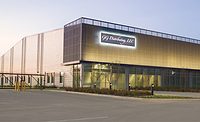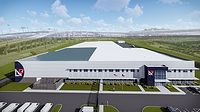Automation, SKU proliferation create a need for advanced lift trucks
Forklifts equip warehouses with the ability to overcome space constraints

The Yale Reliant solution is a new type of advanced operator assistance technology that helps reinforce truck operating best practices as well as support operator awareness.
(Image courtesy of Yale Materials Handling Corp.)
Forklifts are essential for keeping beverage warehouses running productively. As automation, SKU proliferation and technology continue to impact the industry, these pick-and-pack machines have evolved to keep stride.
Now more than ever, beverage warehouses are seeing the need for more advanced forklifts and robotic lift trucks (RTLs). In fact, according to material handling, logistics and supply chain association MHI’s 2021 Annual Report, automation and robotics adoption in warehouses will jump from 38% to 76% within the next five years.
Adapting to rapid growth, space constraints
When it comes to advancements in forklifts and RTLs, industry experts agree that automation and SKU proliferation go hand-in-hand. “Much of the automation has been driven by SKU proliferation,” says Andre Marshall, product manager at Doosan Industrial Vehicle America Corp., Buford, Ga. “Consumers are interested in a variety of flavors and beverage options, making it very difficult to warehouse in traditional settings. Today’s managers are pushed to expand their product offerings while staying within the same warehouse space.
“Thus, picking equipment is required to travel higher and narrower aisles to pull merchandise for shipment, while keeping operators safe and productive,” he continues. “The incorporation of automated guided forklifts [or RTLs] has become more mainstream.”
Mark Koffarnus, national accounts director for Yale Materials Handling Corp., Greenville, N.C., echoes similar sentiments on the space challenges affecting warehouse operations. “Consumer demand for beverage selection and availability mean distributors are challenged to house more SKUs,” he says. “Unfortunately, operations can’t afford to overlook space challenges — capacity has become a critical measurement for high-performing warehouses.”
Koffarnus warns that warehouses with insufficient storage and overflowing inventory might unintentionally result in inefficient slotting and storage methods, which can lead to disorganized picking practices and longer travel paths.
To maximize space, efficiency and productivity, Koffnarus says that RTLs are a reliable option that accommodate a range of horizontal transportation and vertical storage tasks. Additionally, RLTs are well suited to handle repetitive tasks as well as long runs, he adds.
Another reliable option that accommodates horizontal transportation and vertical storage tasks is a quad mast forklift. Quad mast forklifts quickly are becoming the standard in beverage warehouses because they’re able to “push the boundaries of physics by trying to carry and lift multiple pallets to even higher heights than ever before,” says Bill Byrd, a senior sales manager for Toyota Material Handling, Columbus, Ind.
Demand for software, safety strengthens
Given the burgeoning demand for automation as a result of SKU proliferation, forklifts remain vital to beverage warehouses. As such, suppliers continuously are turning to integrated software solutions to further streamline and optimize operations.
“The use of software and telematics in a forklift is a game changer,” Doosan’s Marshall says. “[It allows us to] customize the performance based on the customer and application needs, and gather performance data to improve productivity, all while monitoring the overall health of the truck.”
Furthermore, incorporating telematics helps maximize return-on-investment and reduce downtime while also extending the overall life cycle of the truck, Marshall adds.
In addition to telematics, predictive technology increasingly is becoming popular. Yale’s Koffarnus references a new type of advanced operator assistance technology that has emerged to help reinforce truck operating best practices as well as support operator awareness. “It works by controlling truck performance based on real-time information about the equipment and operating environment. One such system, the Yale Reliant solution, leverages three key technologies to trigger alerts promoting proper operating protocols and automatically adjust lift truck performance based on proximity to pedestrians and obstacles, load weight, equipment status and location-specific rules,” he explains.
Toyota’s Byrd notes that predictive technology is exactly what a majority of inquiries that the company receives. “Customers want the trucks [forklifts and other lift trucks] to be interconnected/integrated with their systems,” he says. “They want to know what’s going to happen before it happens so they can plan for it.”
The adaptation of integrated software solutions certainly enables beverage warehouses to be more productive. It also enables them to be safer. And, according to Byrd, customers now are more safety conscious than ever before, stating that as a result, safety measures have evolved to be much more active as opposed to passive.
“Safety measures have evolved from audible alarms for backup and travel to visual alert devices like strobe or blue lights and light curtains, to camera-based pedestrian detection systems,” Byrd says.
Yale’s Koffarnus also acknowledges the importance of safety and the uptick in demand for enhanced measures. “Safety isn’t an outcome,” he remarks. “Safety is everyone’s job and it must extend across operations and the supply chain. Technology can help companies manage equipment and operator behavior.
“For example, remote data monitoring systems, such as telemetry systems, make critical maintenance data accessible while also providing alerts and fault codes related to hazardous driving behaviors like excessive speeds or impacts,” he continues. “Having access to this kind of data allows organizations to isolate and work on remediating problem areas and reinforce best practices to promote safety.”
As advancements in technology continue to impact the forklift industry, experts predict that the increasing adoption of lithium-ion batteries likely will have the greatest impact. “There is a push for energy efficiency, and at the same time, a push for increased performance from electric forklifts,” explains Martin Brenneman, product manager at Toyota. “As this energy solution becomes more mature in the forklift industry, it will create new opportunities for operator comfort, forklift physical dimensions and usage flexibility.”
Looking for a reprint of this article?
From high-res PDFs to custom plaques, order your copy today!









